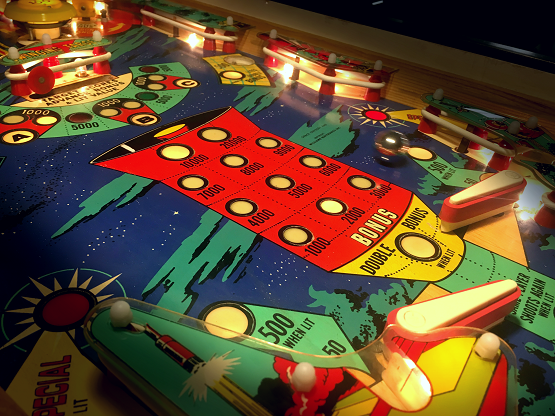Restored by Joseph Henry Group (EPICS)
Project headed by Larry Loprete
“Circuits activated” -Pinbot
L ights are flashing, chimes are ringing, the mechanical click of the flipper echoes in the room… you’re doing everything possible to save the steel ball from gravity’s pull. This is pinball. Since the early 1900s, pinball has been a parlor, bar, and arcade staple in America. The goal is simple: plunge a steel ball onto a slanted playfield and then use a pair of flippers and careful nudging to rack up as many points as you can while preventing the ball from draining down the center or outlanes.
ights are flashing, chimes are ringing, the mechanical click of the flipper echoes in the room… you’re doing everything possible to save the steel ball from gravity’s pull. This is pinball. Since the early 1900s, pinball has been a parlor, bar, and arcade staple in America. The goal is simple: plunge a steel ball onto a slanted playfield and then use a pair of flippers and careful nudging to rack up as many points as you can while preventing the ball from draining down the center or outlanes.
What began as a simple Plinko-like game of chance has evolved into an eye-catching test of skill that is as interesting to play as it is to learn about. Inside every pinball machine are dozens of solenoids, wires, stepper units, and other electronic devices that interact with the ball. In early “electro-mechanical” pinball machines, such as Space Odyssey, the entire game is controlled via an elaborate circuit of relays, switches, and solenoids. There are no circuit boards and there is no computer – everything is done by essentially “rewiring” the machine to activate certain elements, utilizing many principles discovered by Joseph Henry in the 1800s.
 Thus, we (the Joseph Henry group) were excited to purchase a space-themed pinball machine to restore as part of EPICS. Its theme also ties in well to the MAE dept. The pinball machine was in good shape cosmetically, and decent shape mechanically. However, there was still a lot of work to be done before it would play properly. Our process is outlined on the “Restoration Process” page. Overall, it was a challenging project that required lots of patience and puzzle-solving, but it taught us how to read complicated schematics and relate those to the mechanical devices in the machine to diagnose problems.
Thus, we (the Joseph Henry group) were excited to purchase a space-themed pinball machine to restore as part of EPICS. Its theme also ties in well to the MAE dept. The pinball machine was in good shape cosmetically, and decent shape mechanically. However, there was still a lot of work to be done before it would play properly. Our process is outlined on the “Restoration Process” page. Overall, it was a challenging project that required lots of patience and puzzle-solving, but it taught us how to read complicated schematics and relate those to the mechanical devices in the machine to diagnose problems.
Note: Sources listed under the “Websites” link.